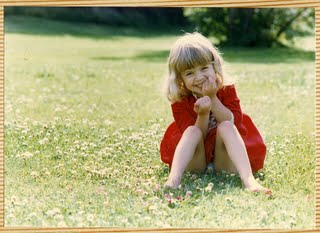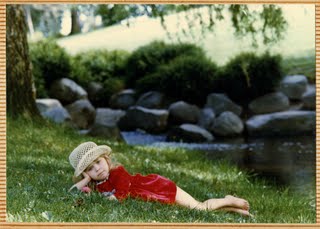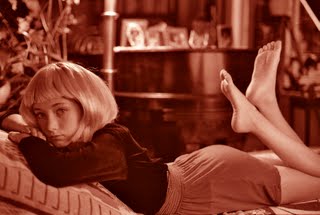Between Child & Woman
Thursday, December 17, 2009

In the summer of 1994 Celia Duthie asked me to review a photography book for her beautiful little review magazine, The Reader. The book was a book that had caused some controversy in the US. It was Sally Mann’s Immediate Family. That book has been in my mind since and more so recently. The colour pictures you see here I took of Hilary (Rebecca’s mother) in the 70s, at Queen Elizabeth Park when she was 5. When she was 13 and her older sister 16 I had local art photographer James La Bounty photograph them. “Why would you do that?” many of my friends asked. “You are a good photographer. Why don’t you photograph them yourself?” My answer was always, “I see them as little girls because I am their father. James will see them, perhaps, as women.” But even then I wasn’t taking photographs of them as I do now of Rebecca. I cannot explain that I may have more fascination for a granddaughter, perhaps because she is that bit more detached from me than my daughters were. Or I could be a better photographer now so the portraits go more to the core of who Rebecca is. Or it could be a combination of that and the fact that Rebecca puts out a face to the world that is impossible not to notice.
Here is what I wrote:
Immediate Family by Sally Mann
Aperture, New York, $34.95
Photographers don’t always talk technical. Was it F-5.6? Was the film dunked in dilution B? They often discuss the last good photograph they took or a photography book that wrenched them out of a long photographer’s block. Few of the many released photo books have this kind of visual power. I ran into photographer Fred Herzog in Kitsilano recently. He complained to me: “The problem with the Vancouver Public Library is that most of their photography books are by John Hedgecoe.” This prolific English photographer of countless how-to books is photography’s answer to Barry Manilow.

Photography books are not a recent phenomenon, although Richard Avedon’s plan to publish 10 in the next little while might be pushing the dreaded photographer’s bet-noir – overexposure. Good photo books have been around since Henry Fox Talbot published his Pencil of Nature in 1844. Because halftone reproduction of photographs in books had not been invented yet, Talbot personally hand-pasted his Talbotypes into every book. If you can find one of these it’ll cost you upwards of $250,000. At $90 a copy, George Hurrell’s Hollywood is a bargain.
Style is a rare commodity. Two English photographers of the 19th century, Calcutta-born Julia Margaret Cameron (the Annie Leibovitz of her time) and Charles Dodgson (Lewis Carroll) had style. Both photographed Alice Liddell (the original Alice) and both would have spotted her likeness in the pages of Sally Mann’s Immediate Family.
Between 1985 and 1990, American photographer Sally Mann photographed her three children, son Emmett and daughters Jessie and Virginia, at home in the nearby foothills of the Blue Ridge Mountains. The black and white photographs were all crisply taken with an 8x10 camera, a big and cumbersome item of equipment that Dodgson or Cameron would instantly have been comfortable with. The photographs are pastoral, funny and sad. Some are disturbing. In 1994 it is difficult to look at pictures of near-naked or naked little boys and girls without feeling slightly uncomfortable, even after knowing that these are artfully crafted family photographs taken by their mother. Few, if any, of these photographs would look like traditional family pictures even if they were photocornered onto a black paged album, dates and names in white ink. Perhaps what novelist Ann Beattie said n Mann’s earlier book, At Twelve: Protraits of Young Women, applies: “These girls still exist in an innocent world in which a pose is only a pose – what adults make of that pose may be the issue.”


A paradox of parenthood is that while we parents might boast about how our one-year-old son can walk and talk, we are usually the last to notice when our children cease to be children. French Jesuit Pierre Teilhard de Chardin likened the slow upward journey of primeval slime towards life to ever-diminishing, circular planes from a sliced cone. In many of the photographs, but particularly in Candy Cigarette, 1989 (below), Jessie beckons like Helen for her Paris. She could be on either side of that threshold – Teilhard’s point – between child and woman. She seems to be undecided. But for the moment, captured by Mann’s magic lens, Charles Dogson wrote in Through the Looking Glass:

In a Wonderland they lie,
Dreaming as the days go by,
Dreaming as the summers die…






